Highway to San Patricio
Texas Small Town History Project Palo Alto College |
|
Loraine Rodriguez Cassandra Payton History 1302 |
Robert Hines December 7th, 2006 |
San Patricio, Texas
|
|
Introduction: San Patricio, population 381, is a town abundant with history. Driving through this town, you get the impression of a ghost town. Very few people live here. People who work in this town, often come from areas such as Blunzter, Mathis, and Corpus Christi, Texas. This town was a great land of opportunities for the Irish Settlers who settled the land. San Patrico is one of the actual battle grounds of the Texas Revolution. Stories such as "La Llorona", "The Lady in Green", and the story of one of first women to be executed by hanging, enter your thoughts. When interviews were conducted, one can see how myths and true stories have been intertwined over time.
Before San Patricio was Settled: Karankawa Indians immigrated to the area known as San Patricio and South Texas area from the Caribbean sometime after 1200. They smelled of the alligator oil rubbed on their bodies to keep the mosquitoes away. They were individualists, and took whatever they needed from the land or the white settlers. The women did all the camp chores-cooking, cleaning, disassembling and setting up the tents. The men fought in the wars, hunted and fished. They were well known for their smoke signaling, they could make up to twenty signals to communicate. They were a tribe which practiced rituals considered taboo by most people; they ate their enemies in a ceremony of revenge. By the 1830s the Karankawas had died off, mostly because of war with Stephen F. Austin and Mexican settlers in South Texas. (Guthrie)
Origins: In the 1800's, the Irish came to the United States with hopes for opportunities for land, freedom of
religion, and to be in the land of the free. Two Irishmen named John McMullen, and James
McGloin, came together and became empresarios. Empresarios were given land in return for
bringing in settlers. Together McMullen and McGloin went to New York to search for Irish
immigrants. They advertised in the newspapers and held interviews. They found 35 Irish
families. These families where promised to be granted land in return for settling. They were
brought to Refugio. Once they arrived, they were asked to leave because Refugio had already
been granted to other families. Some of the Irish families stayed in Refugio, and others went to
what is now San Patricio. During that time San Patricio was part of Mexico, so the Irish were
now considered Mexican citizens. The town was officially established in 1834 and was named
San Patricio de Hibernia for Ireland and its patron saint. The settlers unified with the Mexicans.
In around 1834, the population of San Patricio, was said to be around 600. (Hebert)

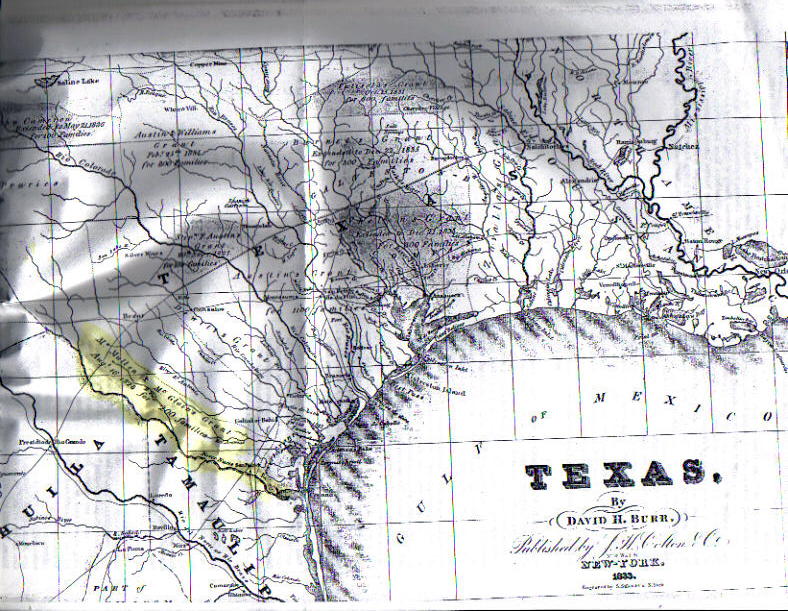
Texas Revolution: In 1835, Refugio and San Patrcio men attempted to cross the Nueces River with a cannon in
attempt to help Texas against Mexico. This mission failed when the cannon fell in the water
while these men were crossing. In Feburary 1836 there was a battle between Mexico and Texas fought on San Patricio land. This battle was a part of the Texas Revolution, San Patricio was
right on the Texas and Mexico border, near the Nueces River. Mexicans would cross
the Nueces River to get to Texas, and vice versa. During this time, Santa Anna supported what
was called the Centralists, this means that he wanted strong control over Mexico, by doing away
with representatives, and to dictate at his will. Townspeople were torn between sides. Most
Hispanics supported the constitution of 1824; therefore, they were on the side of the Texans.
Texans revolted for independence of a separate nation. Some sided with Texas due to empty
promises made by the Mexican government. Some were neutral, some townspeople chose their
side by their religion and faith. In 1836, some Texans camped at San Patricio, and they were
raided by Mexican troops. Some were killed, others were taken prisoner.
Later Santa Anna was captured at San Jacinto, he signed a peace treaty with Texas, making Texas
a republic ending the Texas Revolution.
Saint Patrick's Church: Saint Patrick's Church church was established in 1830 under the direction of Rev. Henry Doyle, the first pastor.
This church was known as the little picket church. In 1858 the church burned down. It was then
rebuilt in 1859, only to be destroyed by the hurricane of 1919. Then in 1922 Rev. E.B. Ledvina
received money from the Extension Society to build a small frame building on the same site of the
old church. Later a bell tower was added and an extension put on the back. In 1961 the church
was remodeled to withstand fire and hurricanes. In 1962 this church was moved to make an
extension to the Community Hall and it was devastated by Hurricane Celia in 1970. Then the
current church that stands on San Patricio was built.
As it is now, back then St. Patrick's church was the center of activities in San Patricio, to include
baptism, confession, communion, and matrimony. This was a place where both the Mexicans
and the Irish could gather. This church had an important role in this town's history. The picket
church was the first community building to be erected in the colony and the first church to be
named for Saint Patrick. During times of war, this was a place for prayer, to provide
townspeople with security. Without this church, we would not have known where to start. We
met many inhabitants of the town who were very wise and knowledgeable. (Hebert) Cemeteries: In San Patricio there are two cemeteries, the "Old Cemetery on the Hill" and the "New
Cemetery". Through oral tradition the old cemetery is said to date back as far as 1811. The first
Mexican settler in San Patricio, Martin De Leon and his family started the cemetery with the
burial of mostly infants at a time when infant death was very common. Then the McMullens and McGloins
continued the traditional grave site. The Empresario James McGloin is buried
there, with many of his sons and a daughter. Of course due to deterioration there are no
gravestones, leaving the grave's location unknown. Men from the Mexican-American war, from
both sides, lie peacefully here. Today many residents or descendants of San Patricio request to be
buried in the old cemetery, in order to be with their ancestors. Although there has been some of a
negligence, such as no official marker for some graves, a bordering fence, or even landscape, people still try to keep it's history and to try to save it. Father Maury requested the new
cemetery, in 1872. It is considered a block-designated cemetery. Stories: The story of Chepita Rodriguez is well known in the town of San Patricio. While speaking with
random townspeople they called Chepita, "La Llorona." Some say she drowned her kids, others
she died defending her son. La Llorona means The Woman Who Cries. She supposedly walks
down by the river crying. Nobody knows why. According to townspeople we interviewed these
stories are myths that have grown. Chepita Rodriguez did have a story. She lived
in San Patricio. She let travelers stay in her home for payment. One day while she was out
in the woods, she heard a gun shot. When she went to check on it, she saw a traveler on the
ground. Riding away, she saw her son. To avoid her son from being in trouble, she buried the
body down by the river. Later the body washed up and was found by a lady washing clothes in
the river banks. The body was wrapped in Chepita's quilt. When the law came to arrest Chepita,
she held her tongue, never to mention her son's involvement. In her trial another traveler testified
in her defense. Still she was found guilty. The jury pleaded the court not to execute by hanging,
but the law of the town insisted, sentencing her to hanging. On a Friday, 13th (around 1836) she was
to be hung under a mesquite tree. Women had no say in the matter, they were very angry. One of
our interviewees stated, "My Great-great-grandmother Lyza Sullivan had a boarding house
across the street from the jail. Lyza, bathed Chepita, and plaited her hair, and gave her my Great
Grandmother's dress. " (Geraldine McGloin)
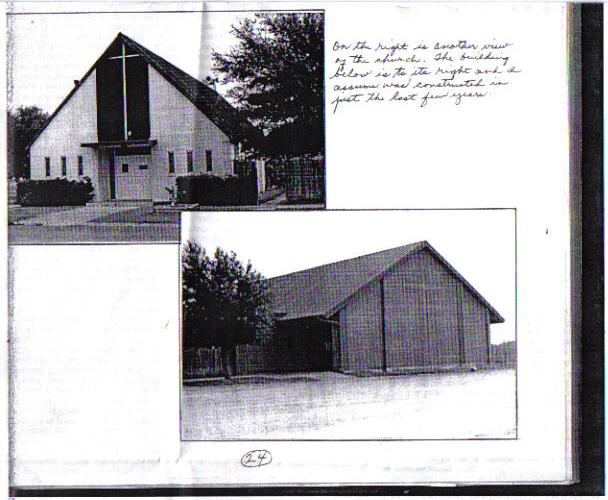
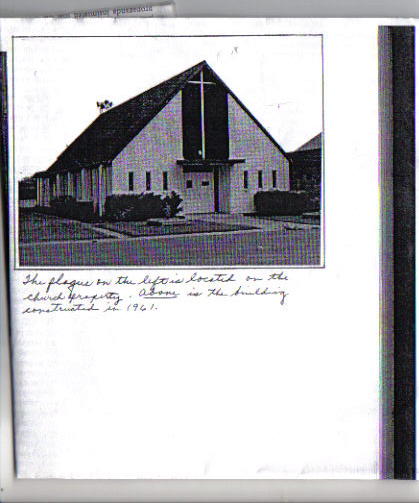

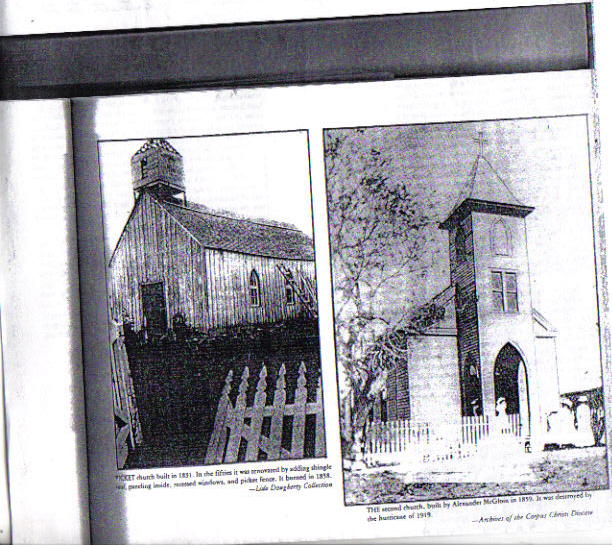
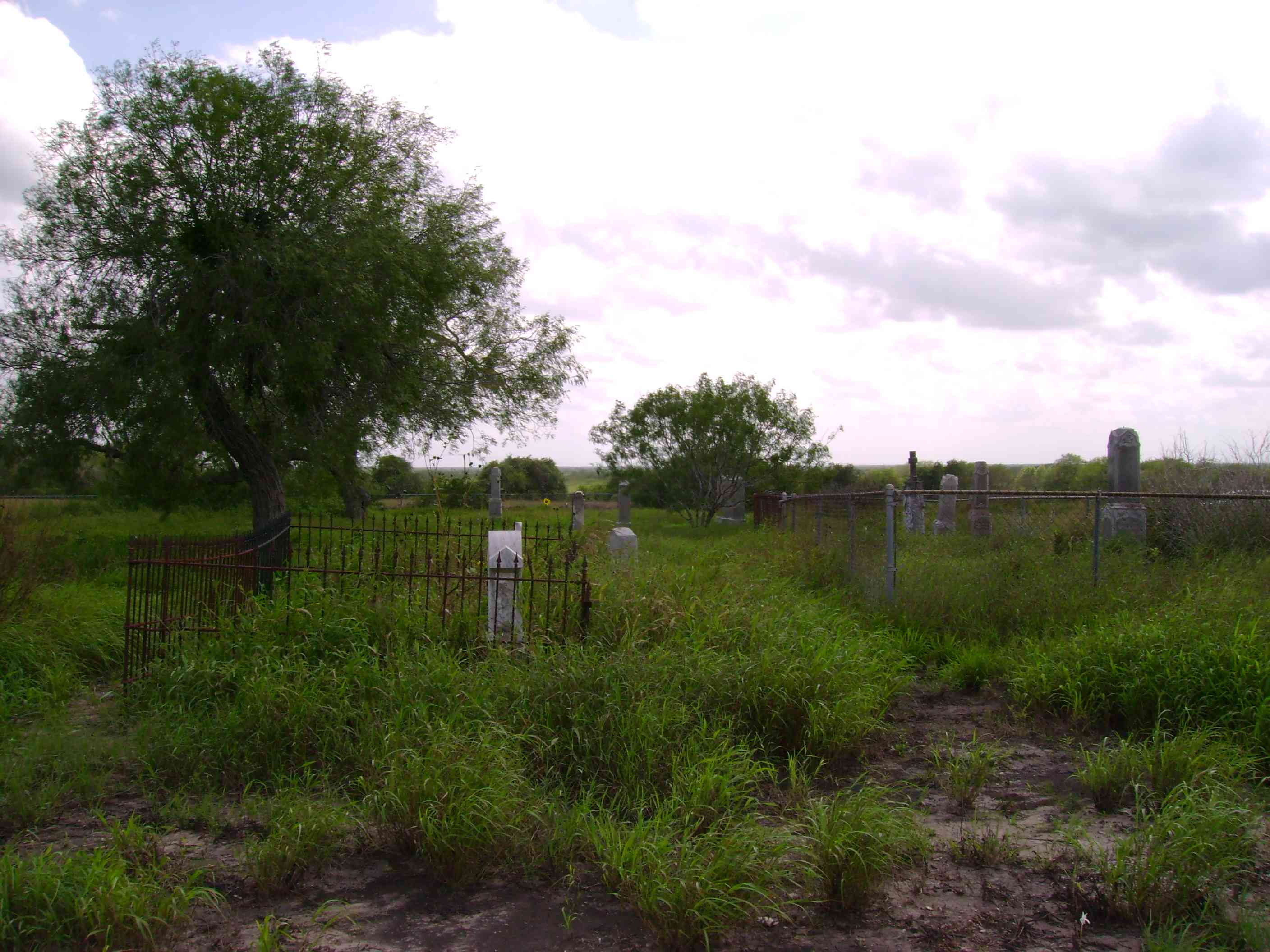
There is a poem in the Forgotten Colony that helps portray her final thoughts to us. Visualize Chepita walking to the tree with the noose dangling,with a wooden cart for her to stand on and a fresh grave near the base of the tree.
"Would she hear this a call to linger?
This leads us to the lady in green. She has also been called "La Llorona," according to the random townspeople we interviewed. Why they called her that, I don't know. The story we came to find out was that the lady in green never cried. A story told by Mary Ann McGloin to Rachel Bluntzer states that Mary Ann's husband had a uncle who knew this woman. This woman had no name in our findings. Back in Ireland this woman loved the uncle. Once she wore a green dress and he never noticed it. She in a mischievous way said, that when she died, she would haunt him, and it would be on a lake, and she would be wearing her green dress and bonnet. He laughed and told her that he would be waiting. He then moved and settled in San Patricio, leaving her behind. Mary Ann McGloin saw her ghost walking over the river in a green dress, with a bonnet. (Hebert)
Then the heavens arced above her,
Once a riot of sunset hues,
Faded into hazy blues.
Dusk had spread her misty cover
Over the river and wooded bottoms.
There in the hush of twilight beauty
She had chosen Death as duty."(Hebert)
Chepita never revealed her son's crime. She referred to her son
as a phantom son, telling us that he was never there. She
felt it was her duty as his mother.
Who really is "La Llorona," we may never know. There are many stories saying she is from other towns as far south as Mexico. I was told there are have been different people to say they have seen a lady crying by a river. Is there only one "La Llorona?" We may never know.
Present Day San Patricio: Today San Patricio still exists. Fairs are held yearly to honor St. Patrick at St. Patrick
Catholic Church. Here descendants gather to display their links to the town. You can see
pictures going back to the 1830's. This is were we met our interviewees. It is here, where you can
see this town will never die. As long as people like Michael McCown, Geraldine
McGloin, and Joan Bluntzer, keep memories of their town alive. Of course there are many more,
who we wished we could have interviewed. This town is filled of many memories, secrets, and
treasures waiting to be uncovered. Researchers come and dig in search of uncovering the
mysteries of this town. Some have found Indian arrow heads, and other historical objects. You
never know what will be found next.
As for the future of San Patricio. It is minutes away from Corpus Christi. Corpus Christi is getting bigger and people are looking to build along Corpus Christi. This will bring people to build in that area and lead to the growth of San Patricio. One thing that will be there always now and in the future will be the friendly citizens of San Patricio. Interviews Annotated Bibliography
Name: Geraldine D'Unger McGloin (No picture)
DOB: 12-18-1938
Parents: Justine Bluntzer D'Unger and Gerald D'Unger
Siblings: 1 sister and 2 brothers
Born: Born and Raised in Corpus Christi
Education: Graduated high school and college
Occupation: Worked mainly in schools and in development
Was Married /Spouse: John Patrick McGloin
Where married: Corpus Christi
Interest regarding Religious/ Political Affiliation: Catholic/Republican
Social Economic Status: Widow
Hobbies: Historical research and writing
Interviee's connection to town: Family for generations back, came from San Patricio.
Husband's family, the McGloin's, date back to 1824.
Her family, the D'Unger's, date back to the 1850's.
The founders of the town: James McGloin and John McMullen (From Ireland)
James McGloin is Geraldine's husbands' great-great-grandfather.
Geraldine is still in search of the Mexicans that lived in the town before James McGloin and John McMullen came, to obtain more history of the town.
Comments: Mrs. McGloin was an excellent source because her family is from this town. She has also done historical research on this town. She was very informative.
Name: Michael DeWitt McCown(See below for picture)
Date of birth: November 1,1945
Parents: Joseph Hugh McCown and Ada Magee
Born: West Columbia
Raised: Various Travels. His father worked for the pipe line division for Texaco.
Places Lived: West Columbia, Houston, San Patricio (Corpus Christi), Harlingen, El Campo
Education: Bacheor's degree in history
Occupation: Computer Analyst/Programmer for over 30 years
Wife: Sue Ann Minkllemann
Married: September 5,1970
Where: Chapel Hills Texas
Children: None
Interest regarding Religious/ Political Affiliation: Catholic/Republican
Military Staus: Served in Marine Corps 1967-1970
Served Marine Corps Reserves until 1992
Retired 1992
Hobbies: History and family genealogy
Connection to topic: His family came to San Patricio in 1861.
Comments: Mr. McCown was an excellent source because his family is from San Patricio, and he also was an historian, so he gathered a lot of information on the town. He was very informative.
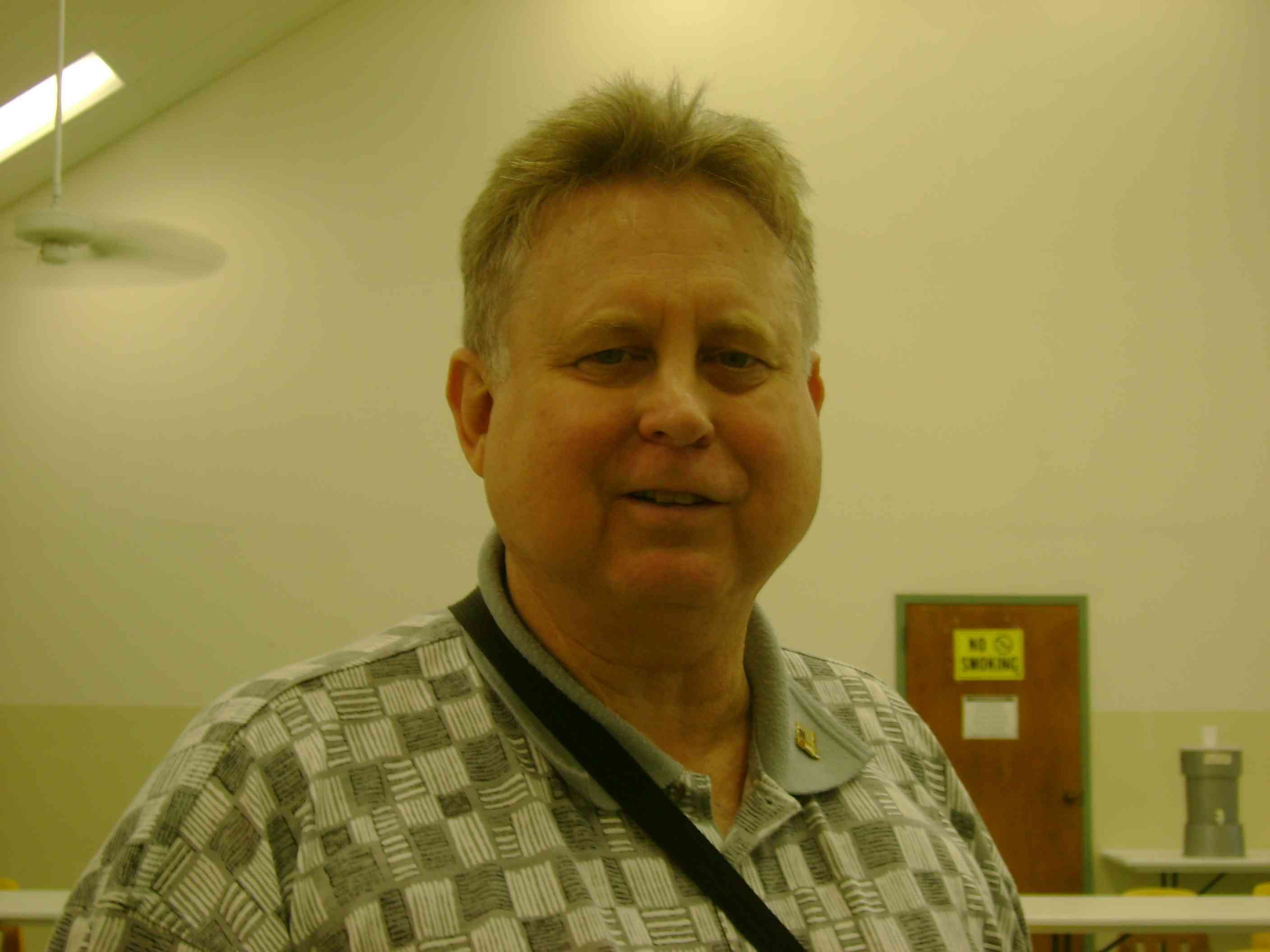
Michael McCown
Name: Lonnie McCown (See below for picture)
Date of Birth: 11/20/1942
Name of Parents: Albert & Faye McCown
Siblings: Brother Jerald McCown
Born/ Raised: San Patricio
Education: College at A&I- Kingsville
Occupation: Financial planner
Spouse's Name: Meralyn McCown
Children: 2 sons
Military Status: Was in Vietnam
Connection: Not only because he lived in San Patricio, but his family built a foundation here. His father worked on ranches and the local General Store. Lonnie was a great source for this project, he shared stories and pictures, which we truly appreciated. He told us of the Mexican man with the big sombrero that would fill up big jugs with water on his donkey that he got from the General Store, then walked to door to door providing water to the townspeople. McCown talked about how he didn't get to finish his bachelors degree due to a bad car accident and then when he was about to return he was drafted (lottery) off to war. He shared information of how the people made their money from ranching, distributing coal, and was a part of the new railroad system in San Patricio.
Comments: Lonnie was very informative. He had a lot of pictures and things for us to view from his family collections.
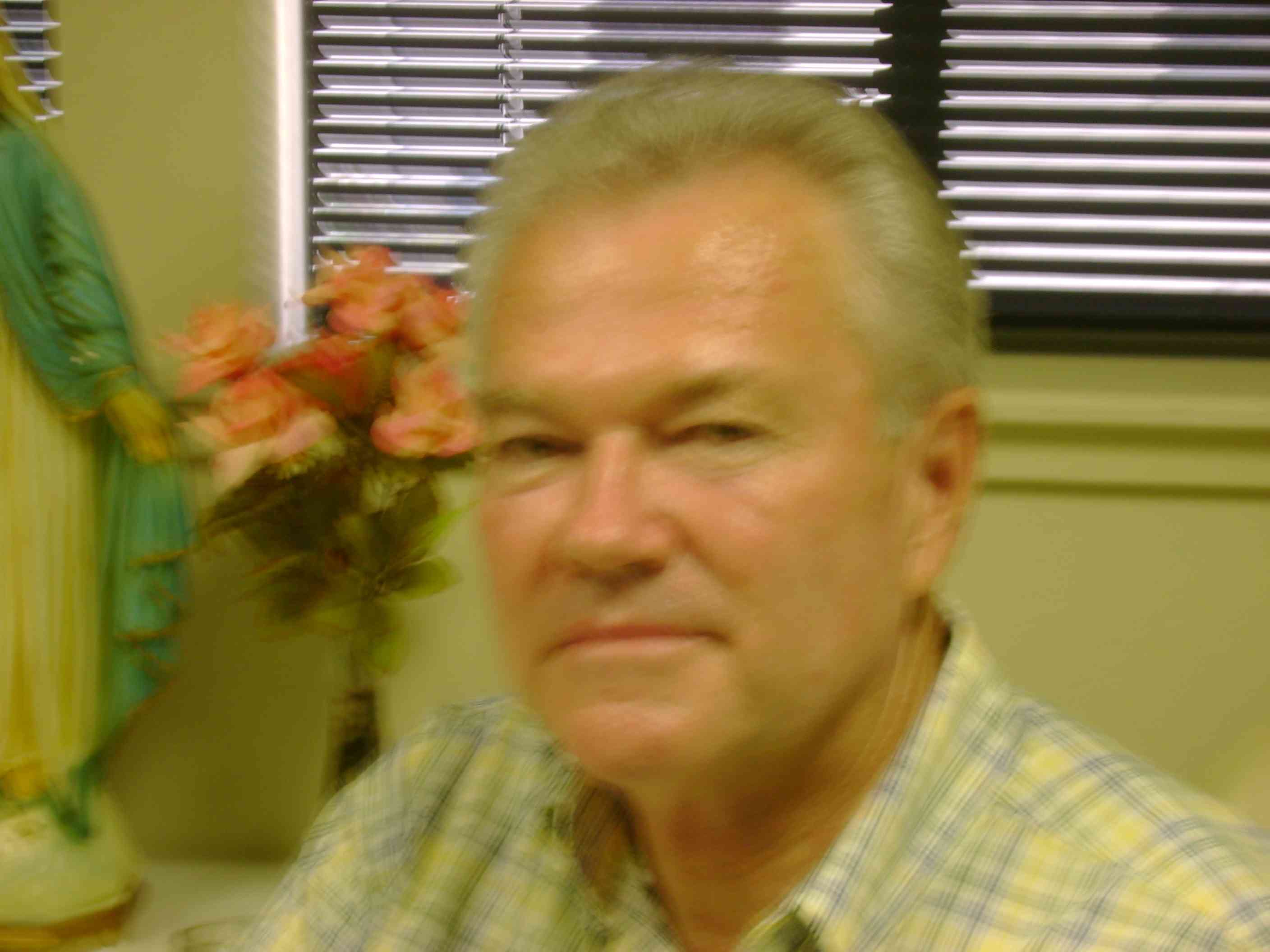
Lonnie McCown
Name: Joan Bluntzer(See below for picture)
Date of Birth: 10/29/1924
Name of Parents: William & Catherine Mahony Bluntzer
Siblings: 2 Brothers and 1 Sister
Born/ Raised: Bluntzer, Texas
Education: Our Lady of the Lake, Corpus Christi Business School
Occupation: General Phone- 26 years, St. Patrick's Church- present, Chairman of the town's Democratic Party
Spouse's Name: Never Married
Hobbies: Cooking, caring for 29 cattle on 300 Acres
Connection: Her mother lived in San Particio and is originally from County Cork in Ireland. Her mother taught school at the Picket Church (first church in San Patricio). Ms. Bluntzer was such a joy to interview, she always had a smile. She shared much information about the settlers that arrived here with McGloin and McMullen. She told us that each family received about 660 acres for 4 cents an acre. She lives in Bluntzer that is near San Patricio, or in her words "A hop, skip away".
Comments: Mrs. Bluntzer was a great source because of her mother's history with the town, and she still lives near San Patricio.
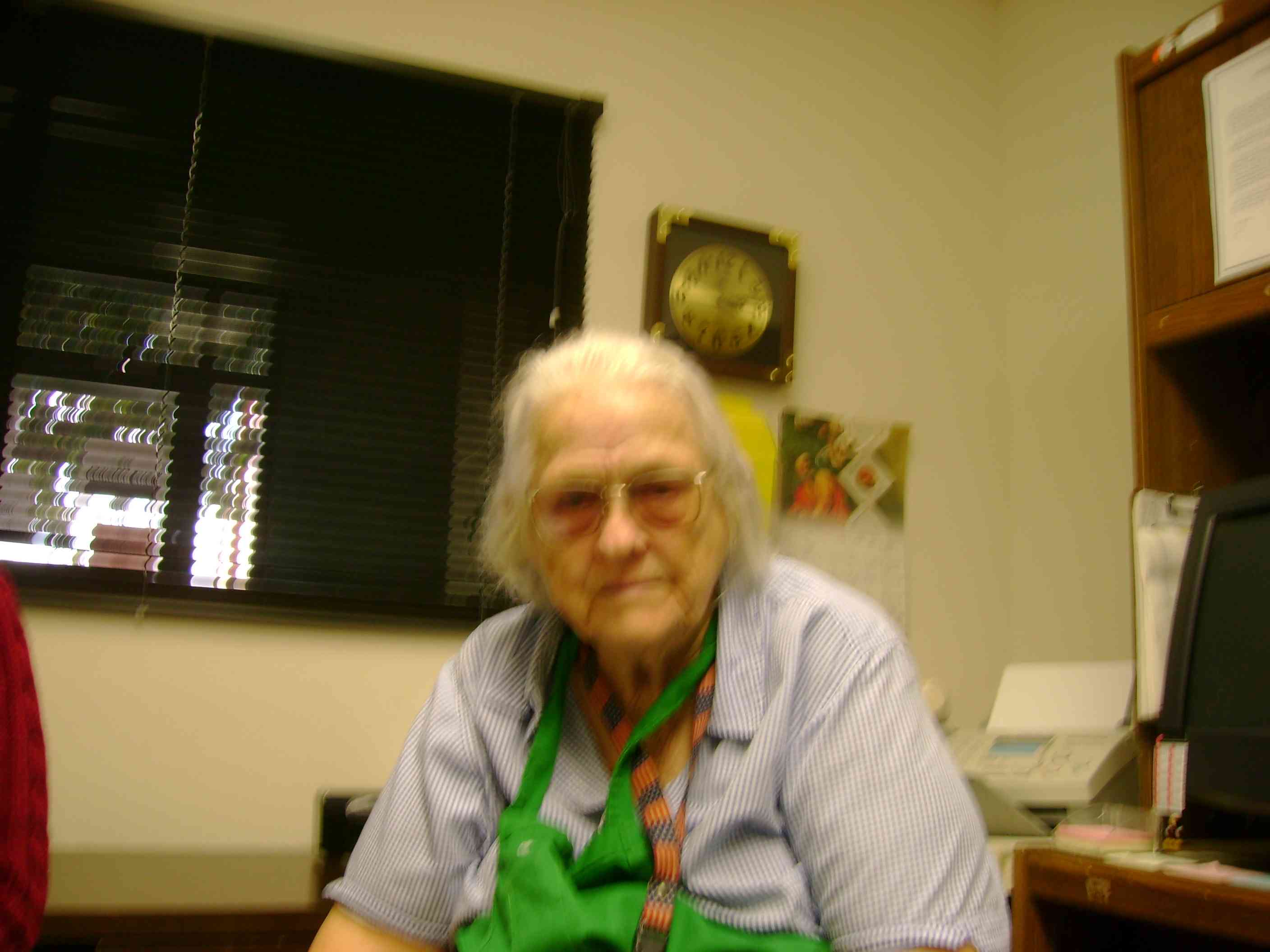
Joan Bluntzer
Books
Hebert, Rachel Bluntzer. "The Forgotten Colony: San Patricio De Hibernia." Texas: Eakin Press, 1981.
This book was a great source because she has combined the basic research of the town with poetic sources.
Guthrie, Keith. "History of San Patricio County." Texas: Nortex Press, 1986.
Smallwood, Lannette. "Old Town Patricio: Frontier Colony of the Irish." South Texas Traveler Magazine. September 2006.
This article summarizes the origins of San Patricio.
Sayger, Bill. "A San Patricio Remembrancer."
No further information obtained.
This book put together with copies of pictures and information. This seemed not to be published. This book I only found at San Patricio Church.
South Texas Traveler Magazine, "Le Corpus Christi/ Mathis"
Historical points of intersest around the Lake and Mathis. San Patricio is briefly mentioned as a historical marker.
History of San Patricio. Book Located in the San Antonio Library.
This source has a great amount of history and present day of San Patricio.
Internet
http://www.texasescapes.com/TexasGulfCoastTowns/BluntzerTexas/BluntzerTx.htm
Look here for information on Bluntzer, Texas.
http://www.tsha.utexas.edu/handbook/online/articles/MM/hfm3.html
Look here for information on Mathis, Texas.
http://www.cctexas.com/
For more information on Corpus Christi, Texas.
http://en.wikipedia.org/wiki/San_Patricio,_Texas">http://en.wikipedia.org/wiki/San_Patricio,_Texas">http://en.wikipedia.org/wiki/San_Patricio,_Texas
Find out statistics of San Patricio such as geography, census reports, and maps.
http://www.tsha.utexas.edu/handbook/online/articles/SS/hls13.html
This source gave a small article of the beginning of San Patricio, when the Mexico owned it to the Irish founders.
http://www.lallorona.com/La_index.html
See different stories of La Llorona.
http://www.tamu.edu/ccbn/dewitt/irishchipita2.htm
Find out about the Lady in Green from Texas.
http://www.texasindians.com/karank.htm
For information on Karankawa indians see this site.
http://www.tsha.utexas.edu/handbook/online/articles/MM/fmc94.html
For information on John McMullen.
http://www.tamu.edu/ccbn/dewitt/irishmcgloin.htm
For information about James McGloin.
http://users.ev1.net/~iverson1/texas_history/empresarios_of_texas.htm
For information on empresarios.
http://pacweb.alamo.edu/InteractiveHistory/projects/rhines/StudentProjects/2001/Refugio/SmallTownResearchProject.htm
For information on Refugio, Texas.
http://www.tamu.edu/ccbn/dewitt/irishmcmullen.htm
For information on San Patricio De Hibernia.
http://www.tsha.utexas.edu/handbook/online/articles/NN/rnn15.html
For information on the Nueces River.
http://www.tsha.utexas.edu/handbook/online/articles/TT/qdt1.html
For information on the Texas Revolution.
http://www.lsjunction.com/people/santanna.htm
For information about Santa Anna.
http://www.tsl.state.tx.us/treasures/republic/san-jacinto.html
For information about San Jacinto, Texas.
http://www.tamu.edu/ccbn/dewitt/irishcem.htm
For information on Rev. E.B. Ledvina.
www.tamu.edu/ccbn/dewitt/irishcem.htm
For information on the Old Cemetery on the hill.
http://www.tamu.edu/ccbn/dewitt/irishchipita.htm
For information about Chepita Rodriguez.
Places
Old San Patricio Trading Co., 4813 FM 666, Mathis, TX 78368. Phone (361) 547-5507.
Saint Patrick's Mission Catholic Church
Phone (361) 547-5748. This church has been a part of San Patricio's history since around the 1800's.
The Old San Patricio Cemetery
This source shows us where the founders and their decedents have been buried. These graves contain vital information to help develop links between townspeople, and they also serve as a time line.
The Old San Patricio Courthouse
This source directs us to the place were many historical cases have been held, e.g., the case of Chepita Rodriguez (A.K.A. La Llorona).
Santa Margarita Passing
This historical landmark was used to transport things, e.g., soldiers, equipment, food, residents.
Texas Map in 1833
This map shows us numerous grants in 1833.
The Old Dougherty House
This source is a landmark directing us to the home of St. Paul's Academy for boys, owner Robert Dougherty. He was an Irish refugee from the 1840s of San Patricio.
Nicholas Bluntzer Ranch House
Built in 1874, in San Patricio. One of the first settlers in San Patricio.